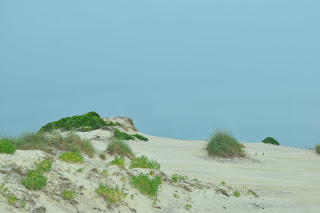Sunday, July 3, 2011
A Night in Rodanthe...
Established in 1953, Cape Hatteras National Seashore occupies almost half of North Carolina's Outer Banks, a 200-mile long archipelago of low, narrow barrier islands. They provide protection for the shoreline from the rough waters and battering winds of the Atlantic Ocean, while offering a largely unspoiled playground for fishermen, wind surfers, kite boarders, surfers, hang gliders and beachcombers.
Miles and miles of protected dunes march along both sides of US 12, some of them towering to an astonishing 30 feet or so. Fences, sea oats, and beach grasses do a herculean job of keeping the dunes in place.
More than a million migratory birds and the threatened loggerhead sea turtles make the almost 6,000 acre Pea Island National Wildlife Refuge their nesting grounds in the spring and fall.
The Cape Hatteras Lighthouse is the tallest in the country made of brick. At 210 feet tall with a black and white spiral stripe, it is a sight to behold as we approach it from the north. Built in 1870, it is the icon for the North Carolina coast.
Camping in Rodanthe, one of the beachy beach communities, is a breeze...a stiff one! Recalling the romantic movie, 'Night in Rodanthe' with Richard Gere and Diane Lane, dining on all-you-can-eat snow crab at 'Good Winds' while watching 30 or 40 kite boarders flip and turn and somersault and race the waves as a blazing sun disappears over the Pamlico Sound in the smoky haze while sipping a Pinot Grigio...ahhh!
On the northern end of the islands, it is a real thrill to finally see the Kill Devil Hills water tower come into view. Kitty Hawk can't be far away now!
It was a freezing cold, gusty day on December 17, 1903, as two brothers, Orville and Wilbur Wright, from Dayton, Ohio, changed the world forever. On that morning, they made the first sustained flight in a heavier than air motorized machine.
During the first attempt, with Orville at the helm, having won the coin toss, the sensitive elevators pitched the small craft like a bucking bronco resulting in a sustained flight of only 120 feet in 12 seconds, which was recorded in the famous photograph, now immortalized in this life-sized sculpture.
Each successive attempt resulted in longer and longer distances and time aloft. The final flight was 852 feet and lasted 59 seconds! In the next two years, they developed their flying machine into the first practical fixed-wing aircraft. They were not the first to build and fly experimental aircraft, but the Wright brothers were the first to invent aircraft controls that made fixed-wing powered flight possible.
Orville Wright's account of the final flight of the day:
"Wilbur started the fourth and last flight at just about 12 o'clock. The first few hundred feet were up and down, as before, but by the time three hundred ft had been covered, the machine was under much better control. The course for the next four or five hundred feet had but little undulation. However, when out about eight hundred feet the machine began pitching again, and, in one of its darts downward, struck the ground. The distance over the ground was measured to be 852 feet; the time of the flight was 59 seconds. The frame supporting the front rudder was badly broken, but the main part of the machine was not injured at all. We estimated that the machine could be put in condition for flight again in about a day or two."
And the world has continued to shrink ever since...
Subscribe to:
Post Comments (Atom)











1 comment:
Love this last shot with the trailer in the background! What an adventure!
Post a Comment